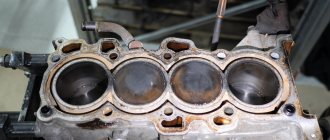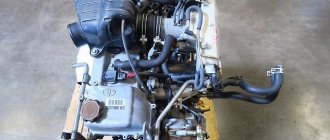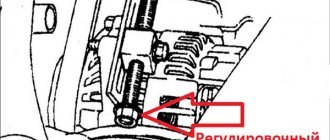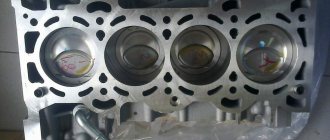The G4KE engine, which powers common Korean cars, has been produced at the Slovak plant since 2007 and represents the Theta II family. In the first variations of the engine, one phase regulator was installed, a pan of a different volume, and less oil circulated in the system.
The material contains details about the characteristics, features, maintenance and weak points of the Hyundai G4KE power plant, including one of the most common problems - turning connecting rod bearings.
G4KE Engine Characteristics
The cylinder block of the G4KE in-line injection engine is made of aluminum. The design provides 4 cylinders with four valves on each. The volume of 2358 cm3 was obtained by increasing the piston stroke to 97 mm, and the cylinder diameter was also expanded to 88 mm. The compression ratio remained at 10.5. Power, depending on the modification, is 172, 177 or 180 “horses”. The torque rating can also be 225, 229 and 231 Nm. The timing drive is chain.
Recommended fuel is 95 and above. In accordance with environmental standards, the G4KE installation belongs to the Euro 4/Euro 5 type. Engine oil consumption of up to 600 ml is allowed per 1 thousand kilometers. The type of lubricant recommended by the technical specifications is 0W-40, 5W-30 and 5W-40, 4.6 liters circulate in the system . According to the manufacturer's recommendations, the oil should be changed every 15 thousand km, but based on experience, it is better to reduce the interval to 7.5. The optimal temperature is 90 degrees. The factory data on the resource approximately coincides with the real one - the engine “runs” 200-250 thousand km.
Fuel consumption
The actual fuel consumption of the engine depends on the model of the car in which it is installed. Let's look at the performance that the G4KE demonstrates using the examples of the all-wheel drive Kia Sportage 3 and the 3rd generation Hyundai Santa FE based on a 6-speed automatic transmission.
Kia in the city consumes 11.2 liters per 100 km. On the highway, the volume of fuel consumed is 8.4 liters.
The engine installed on the Hyundai Santa Fe 3 requires 13.4 liters in the urban cycle. In suburban mode - 7.2 liters. Mixed consumption is 9.5 liters for every 100 km.
Characteristics
| Production | Hyundai Motor Manufacturing Alabama Shandong plant Hwaseong plant |
| Engine make | G4KE |
| Years of manufacture | 2009-present |
| Cylinder block material | aluminum |
| Supply system | injector |
| Type | in-line |
| Number of cylinders | 4 |
| Valves per cylinder | 4 |
| Piston stroke, mm | 97 |
| Cylinder diameter, mm | 88 |
| Compression ratio | 10.5 |
| Engine capacity, cc | 2359 |
| Engine power, hp/rpm | 172/6000 177/6000 180/6000 |
| Torque, Nm/rpm | 225/4000 229/4000 231/4000 |
| Fuel | 95+ |
| Environmental standards | Euro 4 Euro 5 |
| Engine weight, kg | — |
| Fuel consumption, l/100 km (for Kia Sorento) - city - highway - mixed. | 11.47.2 8.8 |
| Oil consumption, g/1000 km | up to 600 |
| Engine oil | 0W-40 5W-30 5W-40 |
| How much oil is in the engine, l | 4.6 |
| Oil change carried out, km | 15000 (better 7500) |
| Engine operating temperature, degrees. | ~90 |
| Engine life, thousand km - according to the plant - in practice | — ~200 |
| Tuning, hp — potential — without loss of resource | 200+ — |
| The engine was installed | Kia Cerato Kia Optima Kia SportageKia SorentoHyundai ix35 Hyundai Sonata Hyundai Santa Fe Hyundai Tucson |
Technical features
The 2.4-liter G4KE is a Korean variation of the Japanese 4B12 engine produced by Mitsubishi (Chrysler World in the American version), developed on the basis of the G4KD unit. The cylinder block is made of aluminum; with a constant height of 220 mm, the cylinders have increased in diameter to 88 mm. Crankshaft with eight counterweights. A larger piston stroke (97 mm) made it possible to increase the volume of the power plant to 2.4 liters. Also, the G4KD and G4KE engines are distinguished by the presence of balancing shafts and a modified sump for the latter.
The cylinder head is equipped with 16 valves, the intake shaft takes advantage of the CVVT system, which provides variable valve timing. Some configurations have 2 phase shifters (intake and exhaust). The torque is transmitted to the camshafts by the timing chain. The timing chain life of the G4KE engine is about 150 thousand km. There are no hydraulic compensators, which is why gaps are diagnosed at intervals of 75-95 thousand km and adjusted if necessary. The intake manifold operates in two modes.
Malfunctions and repairs of the G4KE 2.4 l engine
The G4KE engine belongs to the Theta II family and is a Korean implementation of Mitsubishi 4B12 or Chrysler world engines. This modification is based on the 2.0-liter G4KD. There is almost the same aluminum cylinder block, but the cylinder diameter has been increased to 88 mm, and the height has not changed - 220 mm. Inside there is a crankshaft with 8 counterweights and a piston stroke of 97 mm, connecting rods of 143.75 mm, pistons with a height of 27.5 mm. Thanks to such a stroker, it was possible to obtain almost 2.4 liters of volume. Here, balancing shafts were added and the sump was changed. Here is the main difference between G4KD and G4KE.
The head is the same as on the G4KD - 16 valves with a CVVT variable valve timing system on the intake shaft, and there are also options with two phase shifters. The camshafts rotate using a timing chain, which lasts for about 150 thousand km. There are no hydraulic compensators here, so you need to check the gaps every 95 thousand km and adjust them as necessary. The intake manifold has variable geometry and has 2 operating modes.
Based on the G4KE, they created a version with direct fuel injection - G4KJ, a modification with longitudinal installation G4KG and an electric G4KK.
Disadvantages and problems of G4KE engines
A pleasant fact is that these engines are practically not subject to scuffing, unlike their 2-liter counterparts, and do not need to be overhauled so quickly. Spraying oil on the balance shafts helps. But here it is possible for the connecting rod bearings to rotate due to oil starvation, which is caused by a drop in the oil level due to the failure of the oil pump, and it is combined with the balancer shaft block. Most often, in such cases, the balancers are removed and an oil pump from G4KD is installed, but then scuffing is possible in the future. Installing oil jets can reduce the risk of scuffing. Otherwise, there are no differences from the G4KD, all the same noises and extraneous sounds, only the resource is now not 150 thousand km, but 200 thousand km or even more. We wrote about the problems of G4KD here.
G4KE Service
We service the G4KE engine
In the G4KE engine, the engine oil and filter are changed every 15 thousand km. Approval requirements: API Service SM, ILSAC GF-4 and higher, ACEA A5 and higher. The air filter is inspected at the same interval. It is recommended to change it every 45 thousand. The fuel filter is replaced every 60 thousand km, just like spark plugs. The level and quality of the cooling system fluid is checked together with a lubricant change (every 15 thousand km); it is recommended to change the coolant at intervals of 45 thousand km. The composition of the liquid should be ethylene glycol. For optimal operation, the system requires 7.1-7.4 liters of coolant, which is a solution of water and antifreeze.
Inspection and adjustment of valves in the G4KE installation is carried out at 75 thousand km. According to the regulations, the timing chain is not serviced, but the mechanism must be monitored, since by 150 thousand mileage it can stretch.
Advantages and disadvantages
The disadvantages include complex overhaul of the power drive:
- cylinder liners, which are considered non-removable, can only be removed from an aluminum block using special equipment;
- There are no repair sizes for CPGs in principle.
However, masters of domestic service stations easily bypass the manufacturer’s restrictions.
The cylinder head is mounted on a gasket with spring-loaded metal elements. Or a metal non-shrink bag is used, before installing which you will have to grind the seating surfaces of both the block and the head. But oil and antifreeze leaks in this case are guaranteed to be excluded.
CPG engine G4KE
The engine is a little “noisy”; with increasing mileage, increased oil consumption is observed. After the hydraulic compensators wear out, a characteristic loud knock appears. However, the first generation of vehicles equipped with this power drive is confidently operating on the roads, which is confirmation of the high service life and margin of reliability.
Disadvantages and weaknesses of G4KE
This engine model has characteristic weaknesses:
- Design features lead to loud operation and vibrations;
- A dirty throttle assembly causes unstable idle speed;
- Owners often complain about breakdowns of the phase regulator and air conditioning compressor bearing;
- At high mileage, intake manifolds often crack.
Problems with scuffing cannot be called a typical disadvantage of the motor due to the fact that the balancing shafts splash with lubricant, but these problems also occur. Instead, a lack of oil caused by a broken oil pump causes the G4KE connecting rod bearings to turn.
Learn more about G4KE earbuds
Turned the liners
- Liner rotation can negatively affect the performance of the G4KE engine, both instantaneously and slowly. In the first option, the engine will stall and will not start. In this case, the cause of the malfunction is the wedge of the balancing block pressure reducing valve. As a result, at low speeds the oil does not flow at the required pressure.
- In the case of gradual damage to the installation, increasing metallic sounds appear. The malfunction is caused by a breakdown of the balancing shaft block and worn journals.
- In most cases, the owners of the 2012 engine faced the problem of turning the liners, since it was in this modification that new, but not entirely successful, developments were implemented. Manufacturers replaced the G4KE liners and connecting rods 3 times; the design of the balancer block, the coating material, the geometry and rigidity of the connecting rods changed, and an additional attachment point appeared.
Turned the liners on G4KE - 2012
To prevent rotation of the bearings and further repairs, it is necessary to reduce the oil change interval to 7-8 thousand km, since the original 5w30 lubricant is not designed for 15 thousand intervals. Also, make sure that the oil level does not fall below the top bar. All this can increase the life of the motor.
Finally, don't drive at low speeds unless absolutely necessary.
At higher speeds, the crankshaft journals are better lubricated. According to the factory's recommendations, it is better to minimize aggressive driving.
G4KE engine malfunctions
Here are the most common problems that occur with this engine.
- Noisy operation, which bothers owners after 50 thousand kilometers. This could be chirping injectors - easily eliminated by adjusting the injector, or increased vibrations associated with worn spark plugs.
- Floating speed due to clogged throttle assembly.
- Failure of the phase regulators and bearing of the air conditioner compressor.
- Failure of the oil pump - it is extremely important to monitor the lubricant pressure, and at the slightest doubt, turn off the engine. Otherwise, problems with the engine cannot be avoided - scuffing on the inner walls of the cylinders is only a small part of what can happen.
Clean throttle
Failures requiring dismantling of the power plant on the G4KE are rare. Basically, removing the head is enough. However, in the absence of proper experience, difficulties may arise.
What cars was G4KE installed on?
The G4KE was installed on the Santa Fe CM.
The G4KE engine was installed on most of the group's most popular cars. Among the Hyundais, the owners of the engine were Santa Fe CM (produced from 2007 to 2012), Santa Fe DM (which replaced the previous generation in 2012-2018), Sonata NF , Sonata YF and Sonata LF (succeeding each other starting from 2008 years to the present), Tucson LM 2009-2015 .
Sportage SL 2010-2015
Kia aggregated G4KE cars Magentis MG (produced in 2008-2010), Optima TF (2010-2015), Sportage SL 2010-2015 , which were replaced by Sportage QL (produced in 2015 and still in production) , Sorento XM and Sorento UM (produced from 2009 to 2014 and from 2014 to present, respectively).
Sorento UM - 2014
Technical characteristics and design
The Hyundai Tucson G4KE engine is a family of Theta II engines. The motor replaced the old Beta series, but with new modifications and improvements. For Chrysler, the series acquired the name Chrysler world.
The G4KE motor is a larger version of the G4KD. Thus, the piston group and exhaust manifold were changed, and the timing system changed. Compared to its predecessors, the engine has become more powerful and stable. It has no structural differences from its younger brother.
Technical characteristics of the Kia Tucson G4KE engine:
| Name | Characteristics |
| Manufacturer | Mitsubishi |
| Motor brand | Hyundai G4KE/ Mitsubishi 4B12 |
| Volume | 2.4 liters (2359 cm3) |
| Injection | Injector |
| Power | 176 hp |
| Cylinder diameter | 88 mm |
| Number of cylinders | 4 |
| Number of valves | 16 |
| Fuel consumption | 8.7 liters for every 100 km in mixed mode |
| Engine oil | 5W-20 5W-30 |
| Resource | 250+ thousand km |
| Applicability except Tucson | Kia Cerato Kia Optima Hyundai ix35 Hyundai Sonata Hyundai Santa FeSanta Fe EnginesMitsubishi Lancer Mitsubishi Outlander Mitsubishi Delica Chrysler 200 Chrysler SebringHyundai Sonata EnginesCitroën C-Crosser Dodge Avenger Dodge Caliber Dodge Journey Jeep Compass Jeep Patriot Peugeot 4007 |










